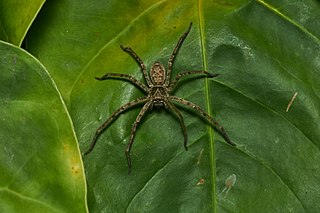
Huntsman spiders, members of the family Sparassidae, are known by this name because of their speed and mode of hunting. They are also called giant crab spiders because of their size and appearance. Larger species sometimes are referred to as wood spiders, because of their preference for woody places. In southern Africa the genus Palystes are known as rain spiders or lizard-eating spiders. Commonly, they are confused with baboon spiders from the Mygalomorphae infraorder, which are not closely related.

The Araneomorphae are an infraorder of spiders. They are distinguishable by chelicerae (fangs) that point diagonally forward and cross in a pinching action, in contrast to the Mygalomorphae, where they point straight down. Araneomorphs comprise the vast majority of living spiders.

Deinopidae, also known as net casting spiders, is a family of cribellate spiders first described by Carl Ludwig Koch in 1850. It consists of stick-like elongated spiders that catch prey by stretching a web across their front legs before propelling themselves forward. These unusual webs will stretch two or three times their relaxed size, entangling any prey that touch them. The posterior median eyes have excellent night vision, allowing them to cast nets accurately in low-light conditions. These eyes are larger than the others, and sometimes makes these spiders appear to only have two eyes. Ogre-faced spiders (Deinopis) are the best known genus in this family. The name refers to the perceived physical similarity to the mythological creature of the same name. This family also includes the humped-back spiders (Menneus).

Heteropoda venatoria is a species of spider in the family Sparassidae, the huntsman spiders. It is native to the tropical regions of the world, and it is present in some subtropical areas as an introduced species. Its common names include giant crab spider, banana huntsman spider or cane spider.
The Halidae were a tiny spider family with only three described species in two genera. As of 2006, this family was no longer considered valid; the two genera are instead grouped in the family Pisauridae.

Heteropoda is a genus of spiders in the family Sparassidae, the huntsman spiders. They are mainly distributed in tropical Asia and Australia, while at least one species, H. venatoria, has a cosmopolitan distribution, and H. variegata occurs in the Mediterranean.
Yule Island is a small island in Central Province, Papua New Guinea. It is located 160 km NW from Port Moresby, on the south coast of Papua New Guinea.

Erieopterus is a genus of prehistoric eurypterid found in Silurian to Devonian-aged marine and freshwater strata of Europe and North America. The genus contains eight species from the Silurian to the Devonian, recovered from both North America and Europe.

The giant huntsman spider is a species of the huntsman spider family Sparassidae found in Laos. It is considered the world's largest spider by leg span, which can reach up to 30 cm (1 ft).

Heteropoda davidbowie is a species of huntsman spider of the genus Heteropoda. It was described from the Cameron Highlands District in peninsular Malaysia and named in honour of singer David Bowie.

Heteropoda cervina, commonly called the brown huntsman, is a large species of spider in the family Sparassidae often found in leaf litter in central Queensland, Australia. The species was first described by Ludwig Carl Christian Koch in 1875 as Sarotes cervinus.
Peter Jäger is a German arachnologist, and current Head of Arachnology at the Senckenberg Research Institute and Natural History Museum in Frankfurt, Germany.
Heteropoda eluta, is a species of spider of the genus Heteropoda. It is endemic to Sri Lanka.
Heteropoda umbrata, is a species of spider of the genus Heteropoda. It is endemic to Sri Lanka.
Heteropoda sumatrana is a species of spiders in the genus Heteropoda, family Sparassidae, found in Indonesia. It was first described by Thorell in 1890.

The Selenocosmiinae are a subfamily of tarantulas found throughout South-East Asia and Australia. This subfamily is defined by the presence of a lyra on the maxillae and strikers on the chelicerae, allowing these spiders to stridulate and produce a "hissing" sound. However some species within Phlogiellus may have secondary lost their lyra but retain their strikers. The monophyly of the subfamily has been only tested using genetic data with a handful of genera or species in a few studies. However, these studies found genera that had been previously placed in this subfamily were actual their own separate subfamily (Poecilotheria) and that Selenocosmiinae is most closely related to the Indian Thrigmopoeinae. As of 2021, Selenocosmiinae contains 11 genera.

Irura mandarina, also known as the Goldenback jumping spider, is a species of jumping spider found in China, Vietnam and India.
Yuri Mikhailovitch Marusik is a Russian arachnologist.

Heteropoda jugulans, sometimes called the brown huntsman, is a species of spider endemic to parts of Eastern Australia. It is a member of the genus Heteropoda of huntsman spider.











